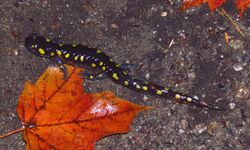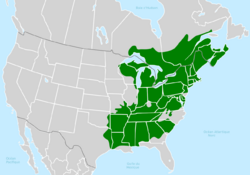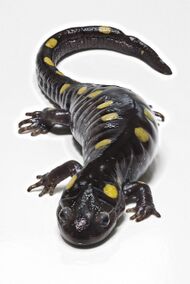Biology:Spotted salamander
| Spotted salamander | |
|---|---|

| |
| Scientific classification | |
| Domain: | Eukaryota |
| Kingdom: | Animalia |
| Phylum: | Chordata |
| Class: | Amphibia |
| Order: | Urodela |
| Family: | Ambystomatidae |
| Genus: | Ambystoma |
| Species: | A. maculatum
|
| Binomial name | |
| Ambystoma maculatum (Shaw, 1802)
| |

| |
| Range of A. maculatum | |
| Synonyms[2] | |
| |
The spotted salamander or yellow-spotted salamander (Ambystoma maculatum) is a mole salamander[2] common in eastern United States and Canada.[1] It is the state amphibian of Ohio and South Carolina. The species ranges from Nova Scotia, to Lake Superior, to southern Georgia and Texas.[3] Its embryos have been found to have symbiotic algae living in and around them,[4] the only known example of vertebrate cells hosting an endosymbiont microbe (unless mitochondria are considered).[5][6]
Description
The spotted salamander is about 15–25 cm (5.9–9.8 in) long.[7] With Females generally being larger than males.[8] They are stout, like most mole salamanders, and have wide snouts.[3] The spotted salamander's main color is black, but can sometimes be a blueish-black, dark gray, dark green, or even dark brown. Two uneven rows of yellowish-orange spots run from the top of the head (near the eyes) to the tip of the tail (dorso-lateral ranging).[9] The spotted salamander's spots near the top of its head are more orange, while the spots on the rest of its body are more yellow. The underside of the spotted salamander is slate gray and pink. Sexual dimorphism, physical differences between males and females, is displayed in the form of larger-bodied females having brighter-coloured spots.[10]
The scientific name Ambystoma maculatum comes from Ambystoma– amblys (Greek) for blunt; -stoma (Greek) meaning mouth; or anabystoma (New Latin) meaning ‘to cram into the mouth’ maculatum – macula (Latin) for spot; maculosus (Latin) for spotted.[11]
Habitat and dispersal
The spotted salamander usually lives in mature forests with ponds or ephemeral vernal pools for breeding sites.[12] Vernal pools are suitable breeding sites for these amphibians as they dry often enough to exclude fish that eat the salamander eggs and larvae, while retaining water long enough to allow amphibian larvae to complete development and metamorphose into terrestrial adults.[13] A study showed larger pools (as opposed to smaller pools) had more egg masses, higher occupancy, and higher larval survival rates for spotted salamanders.[14] Outside of the breeding season, these salamanders spend their time in forests with well-drained soils that contain many burrows dug by small mammals.[8]
Salamander populations from nearby pools form genetically-distinct metapopulations. Subpopulations within 4.8 kilometers share a higher proportion of genes, while populations greater than 4.8 kilometers share a smaller proportion of genes. Inter-population dispersal is likely mediated by both species-specific behaviors and natural limitations.[15]
Behavior
Spotted salamanders are fossorial, meaning they spend most of their time underground. They rarely come above ground, except after a rain or for foraging and breeding. During the winter, they brumate underground, and are not seen again until breeding season in early March–May.[16]
Ambystoma maculatum has several methods of defense, including hiding in burrows or leaf litter, autotomy of the tail, and a toxic milky liquid it excretes when perturbed. This secretion comes from large poison glands around the back and neck. The spotted salamander, like other salamanders, shows great regenerative abilities: if a predator manages to dismember a part of a leg, tail, or even parts of the brain, head, or organs, the salamander can grow back a new one, although this takes a massive amount of energy.[17] As juveniles, they spend most of their time under the leaf litter near the bottom of the pools where their eggs were laid. The larvae tend to occupy refuges in vegetation, and lower their activity in the presence of predators.[18]
Ambystoma maculatum tend to follow the same path in their migration to and from their burrows and breeding pools.[19] They accomplish their journey in conditions that lack visual cues, since it is usually during periods of cloud cover. Some studies show evidence of landmark learning in spotted salamanders. Researchers found that spotted salamanders can associate visual landmarks with food. Thus spotted salamanders may learn landmarks in their habitat that are reliable indicators of resource locations or provide orientation clues for migration to and from breeding ponds.[20]
Diet
Spotted salamanders feed on earthworms, slugs, snails, spiders, millipedes, centipedes, insects, algae and other invertebrates.[21][22] They sometimes also feed on smaller salamanders, such as the red-backed salamander.[23] The adult spotted salamander uses its sticky tongue to catch food.[23]
Lifecycle
During the majority of the year, spotted salamanders live in the shelter of leaves or burrows in deciduous forests. However, when the temperature rises and the moisture level is high, the salamanders make their abrupt migration towards their annual breeding ponds. Recent studies, however, indicate that temperature may be a more important factor than precipitation, as precipitation in winter months increase, yet salamanders do not migrate.[24] In just one night, hundreds to thousands of salamanders may make the trip to their ponds for mating.[16] Males will start a dance-like behavior called a liebsspiel, where afterward they lay down their spermatophore.[25] Males will migrate at higher rates than females early in the migration season. This could be due to different responses to temperature between males and females.[24] Mates usually breed in ponds when it is raining in the spring. Females usually lay about 100 eggs in one clutch that cling to the underwater plants and form egg masses.
The egg masses are round, jelly-like clumps that are usually 6.4–10.2 cm (2.5–4 in) long. The spotted salamander produces a unique polymorphism in the outer jelly layers of its egg masses: one morph has a clear appearance and contains a water-soluble protein, whereas the other morph is white and contains a crystalline hydrophobic protein.[26][27] This polymorphism is thought to confer advantages in vernal pools with varying dissolved nutrient levels, while also reducing mortality from feeding by wood frog larvae.[28][29]
Adults only stay in the water for a few days, then the eggs hatch in one to two months. When the eggs hatch depends on the water temperatures. Eggs of A. maculatum can have a symbiotic relationship with the green alga Oophila amblystomatis.[30] A dense gelatinous matrix surrounds the eggs and prevents the eggs from drying out, but it inhibits oxygen diffusion (required for embryo development).[31] The Oophila alga provides increased oxygen and supplemental nutrition from fixed carbon products via photosynthesis[32] and removes the embryo’s nitrogenous waste (ammonia) in the egg capsule, aiding in the salamander's embryonic development and growth.[33] The developing salamander thus metabolizes the oxygen, producing carbon dioxide (which then the alga consumes). Photosynthetic algae are present within the egg capsule of the developing salamander embryo, enhancing growth. However, the widely used herbicide, atrazine, has been found to significantly lower hatching success rate by eliminating the symbiotic algae associated with the egg masses.[34]
As larvae, they are usually light brown or greenish-yellow. They have small dark spots and are born with external gills. In two to four months, the larvae lose their gills, and become juvenile salamanders that leave the water. Spotted salamanders have been known to live up to 32 years,[35] and normally return to the same vernal pool every year. These pools are seasonal and will usually dry up during the late spring and stay dry until winter.
Spotted salamanders are often preyed on by raccoons, skunks, turtles, and snakes. For this reason they perform an important function by connecting the food chain.[8] Moreover, one of their predators is humans since they are popularly[36] sought out through the pet trade.
References
- ↑ 1.0 1.1 IUCN SSC Amphibian Specialist Group. (2022). "Ambystoma maculatum". IUCN Red List of Threatened Species 2022: e.T59064A193224401. doi:10.2305/IUCN.UK.2022-1.RLTS.T59064A193224401.en. https://www.iucnredlist.org/species/59064/193224401. Retrieved 25 April 2023.
- ↑ 2.0 2.1 Frost, Darrel R. (2021). "Ambystoma maculatum (Shaw, 1802)". Amphibian Species of the World: An Online Reference. Version 6.1. American Museum of Natural History. doi:10.5531/db.vz.0001. https://amphibiansoftheworld.amnh.org/Amphibia/Caudata/Ambystomatidae/Ambystoma/Ambystoma-maculatum.
- ↑ 3.0 3.1 "ADW: Ambystoma maculatum". Animaldiversity.ummz.umich.edu. http://animaldiversity.ummz.umich.edu/site/accounts/information/Ambystoma%20maculatum.html.
- ↑ Petherick, Anna (30 July 2010). "A solar salamander". Nature. doi:10.1038/news.2010.384.
- ↑ Frazer, Jennifer (May 18, 2018). "Algae Living inside Salamanders Aren't Happy about the Situation". Scientific American Blog Network. https://blogs.scientificamerican.com/artful-amoeba/algae-living-inside-salamanders-arent-happy-about-the-situation/.
- ↑ Burns, John A; Zhang, Huanjia; Hill, Elizabeth; Kim, Eunsoo; Kerney, Ryan (2 May 2017). "Transcriptome analysis illuminates the nature of the intracellular interaction in a vertebrate-algal symbiosis". eLife 6: e22054. doi:10.7554/eLife.22054. PMID 28462779.
- ↑ Petranka, J.W. (1998). Salamanders of the United States and Canada. Smithsonian Institution Press. ISBN 9781560988281. https://archive.org/details/salamandersofuni00petr.
- ↑ 8.0 8.1 8.2 Homan, Rebecca N.; Holgerson, Meredith A.; Biga, Lindsay M. (June 2018). "A Long-term demographic study of a spotted salamander (Ambystoma maculatum) population in central Ohio". Herpetologica 74 (2): 109–116. doi:10.1655/herpetologica-d-17-00067.1.
- ↑ Urban, Mark C. (2010-04-12). "Microgeographic adaptations of spotted salamander morphological defenses in response to a predaceous salamander and beetle" (in en). Oikos 119 (4): 646–658. doi:10.1111/j.1600-0706.2009.17970.x. https://onlinelibrary.wiley.com/doi/10.1111/j.1600-0706.2009.17970.x.
- ↑ Morgan, Samantha K. (June 2014). "The spots of the spotted salamander are sexually dimorphic". Copeia 2014 (2): 251–256. doi:10.1643/CE-13-085. https://bioone.org/journals/copeia/volume-2014/issue-2/CE-13-085/The-Spots-of-the-Spotted-Salamander-Are-Sexually-Dimorphic/10.1643/CE-13-085.short.
- ↑ "Spotted Salamander – INHS Herpetology Collection". https://herpetology.inhs.illinois.edu/species-lists/ilspecies/spotted-salamander/.
- ↑ "AmphibiaWeb - Ambystoma maculatum". https://amphibiaweb.org/cgi/amphib_query?where-genus=Ambystoma&where-species=maculatum&account=amphibiaweb#:~:text=Distribution%20and%20Habitat&text=Ambystoma%20maculatum%20ranges%20from%20southeastern,bottomland%20forests%20and%20adjoining%20floodplains..
- ↑ Turtle, Sarah L. (2000). "Embryonic Survivorship of the spotted salamander (Ambystoma maculatum) in roadside and woodland vernal pools in southeastern New Hampshire". Journal of Herpetology 34 (1): 60–67. doi:10.2307/1565239. https://www.jstor.org/stable/1565239.
- ↑ Millikin, Alice R.; Coster, Stephanie S.; Welsh, Amy B.; Anderson, James T. (February 2023). "Pool Age and Local Habitat Are Associated with Effective Number of Breeders in Spotted Salamander Populations Colonizing Created Vernal Pools" (in en). Diversity 15 (2): 124. doi:10.3390/d15020124. ISSN 1424-2818.
- ↑ Zamudio, Kelly; Wieczorek, Ania (2007). "Fine-scale spatial genetic structure and dispersal among spotted salamander (Ambystoma maculatum) breeding populations". Molecular Ecology 16 (2): 257–274. doi:10.1111/j.1365-294X.2006.03139.x. PMID 17217343. https://onlinelibrary.wiley.com/doi/full/10.1111/j.1365-294X.2006.03139.x.
- ↑ 16.0 16.1 Marion, Jonah (April 25, 2018). "Spotted Salamander Migration". https://blogs.cornell.edu/wildlife/2018/04/25/spotted-salamander-migration/.
- ↑ Carlsson, Lars (2010-08-06). "CellNEWS: Salamander Regeneration Trick Replicated in Mouse Muscle Cells". Cellnews-blog.blogspot.com. http://cellnews-blog.blogspot.com/2010/08/salamander-regeneration-trick.html.
- ↑ Brodman, Robert; Jaskula, Jeanette (September 2002). "Activity and microhabitat use during interactions among five species of pond-breeding salamander larvae". Herpetologica 58 (3): 346–354. doi:10.1655/0018-0831(2002)058[0346:AAMUDI2.0.CO;2].
- ↑ Shoop, C. Robert (1965). "Orientation of Ambystoma maculatum: movements to and from breeding ponds". Science 149 (3683): 558–559. doi:10.1126/science.149.3683.558. PMID 17843193. Bibcode: 1965Sci...149..558S.
- ↑ Heuring, W (2014). "Landmark learning by juvenile salamanders (Ambystoma maculatum)". Behavioural Processes 108: 173–176. doi:10.1016/j.beproc.2014.10.015. PMID 25444775.
- ↑ "Spotted salamander (Ambystoma maculatum) : Wildlife Fact Sheet". https://portal.ct.gov/-/media/DEEP/wildlife/pdf_files/outreach/fact_sheets/spottedSalpdf.pdf.
- ↑ "Yellow Spotted Salamander Facts, Habitat, Diet, Life Cycle, Baby, Pictures". 14 June 2016. https://www.animalspot.net/spotted-salamander.html.
- ↑ 23.0 23.1 "The Yellow-Spotted Salamander (Ambystoma maculatum) Care and Info". 10 July 2019. https://crazycrittersinc.com/the-yellow-spotted-salamander-ambystoma-maculatum-care-and-info/.
- ↑ 24.0 24.1 Sexton, O. J.; Phillips, C.; Bramble, J. E. (1990-09-19). "The effects of temperature and precipitation on the breeding migration of the spotted salamander (Ambystoma maculatum)". Copeia 1990 (3): 781. doi:10.2307/1446443. https://www.jstor.org/stable/1446443.
- ↑ "Virginia Herpetological Society" (in en). http://www.virginiaherpetologicalsociety.com/.
- ↑ Hardy, Laurence M.; Lucas, M. Cran (1991). "A crystalline protein is responsible for dimorphic egg jellies in the spotted salamander, Ambystoma maculatum (Shaw) (Caudata: Ambystomatidae)". Comparative Biochemistry and Physiology 100A (3): 653–660. doi:10.1016/0300-9629(91)90385-P.
- ↑ Ruth, Benjamin C.; Dunson, William A.; Rowe, Christopher L.; Hedges, S. Blair (1993). "A molecular and functional evaluation of the egg mass color polymorphism of the spotted salamander, Ambystoma maculatum". Journal of Herpetology 27 (3): 306–314. doi:10.2307/1565152.
- ↑ Pintar, Matthew R.; Resetarits Jr., William J. (2017). "Persistence of an egg mass polymorphism in Ambystoma maculatum: differential performance under high and low nutrients". Ecology 98 (5): 1349–1360. doi:10.1002/ecy.1789. PMID 28247910.
- ↑ Petranka, James W.; Rushlow, Andrea W.; Hopey, Mark E. (1998). "Predation by tadpoles of Rana sylvatica on embryos of Ambystoma maculatum: implications of ecological role reversals by Rana (predator) and Ambystoma (prey)". Herpetologica 54 (1): 1–13.
- ↑ Hutchison, Victor H.; Hammen, Carl S. (1958). "Oxygen utilization in the symbiosis of embryos of the salamander, Ambystoma maculatum and the alga, Oophila amblystomatis". Biological Bulletin 115 (3): 483–489. doi:10.2307/1539111. https://www.biodiversitylibrary.org/part/21027.
- ↑ "Spotted Salamander - an overview | ScienceDirect Topics". https://www.sciencedirect.com/topics/agricultural-and-biological-sciences/spotted-salamander.
- ↑ Graham, Erin R.; Fay, Scott A.; Davey, Adam; Sanders, Robert W. (2013-02-01). "Intracapsular algae provide fixed carbon to developing embryos of the salamander Ambystoma maculatum". Journal of Experimental Biology 216 (3): 452–459. doi:10.1242/jeb.076711. PMID 23038736.
- ↑ Small, Daniel P.; Bennett, R. Scott; Bishop, Cory D. (2014-09-01). "The roles of oxygen and ammonia in the symbiotic relationship between the spotted salamander Ambystoma maculatum and the green alga Oophila amblystomatis during embryonic development" (in en). Symbiosis 64 (1): 1–10. doi:10.1007/s13199-014-0297-8. https://doi.org/10.1007/s13199-014-0297-8.
- ↑ Olivier, Heather M.; Moon, Brad R. (2010). "The effects of atrazine on spotted salamander embryos and their symbiotic alga". Ecotoxicology 19 (4): 654–661. doi:10.1007/s10646-009-0437-8. PMID 19924530.
- ↑ Flageole, Sylvie; Leclair, Raymond (1 April 1992). "Étude démographique d'une population de salamandres (Ambystoma maculatum) à l'aide de la méthode squeletto-chronologique" (in fr). Canadian Journal of Zoology 70 (4): 740–749. doi:10.1139/z92-108.
- ↑ Spinner, Leo (2011-11-30). "Spotted Salamander Care Sheet" (in en-US). https://reptilesmagazine.com/spotted-salamander-care-sheet/.
External links
- Ambystoma maculatum at CalPhotos
- Yellow-spotted Salamander (Ambystoma maculatum), Natural Resources Canada
Wikidata ☰ Q2108247 entry
 |






